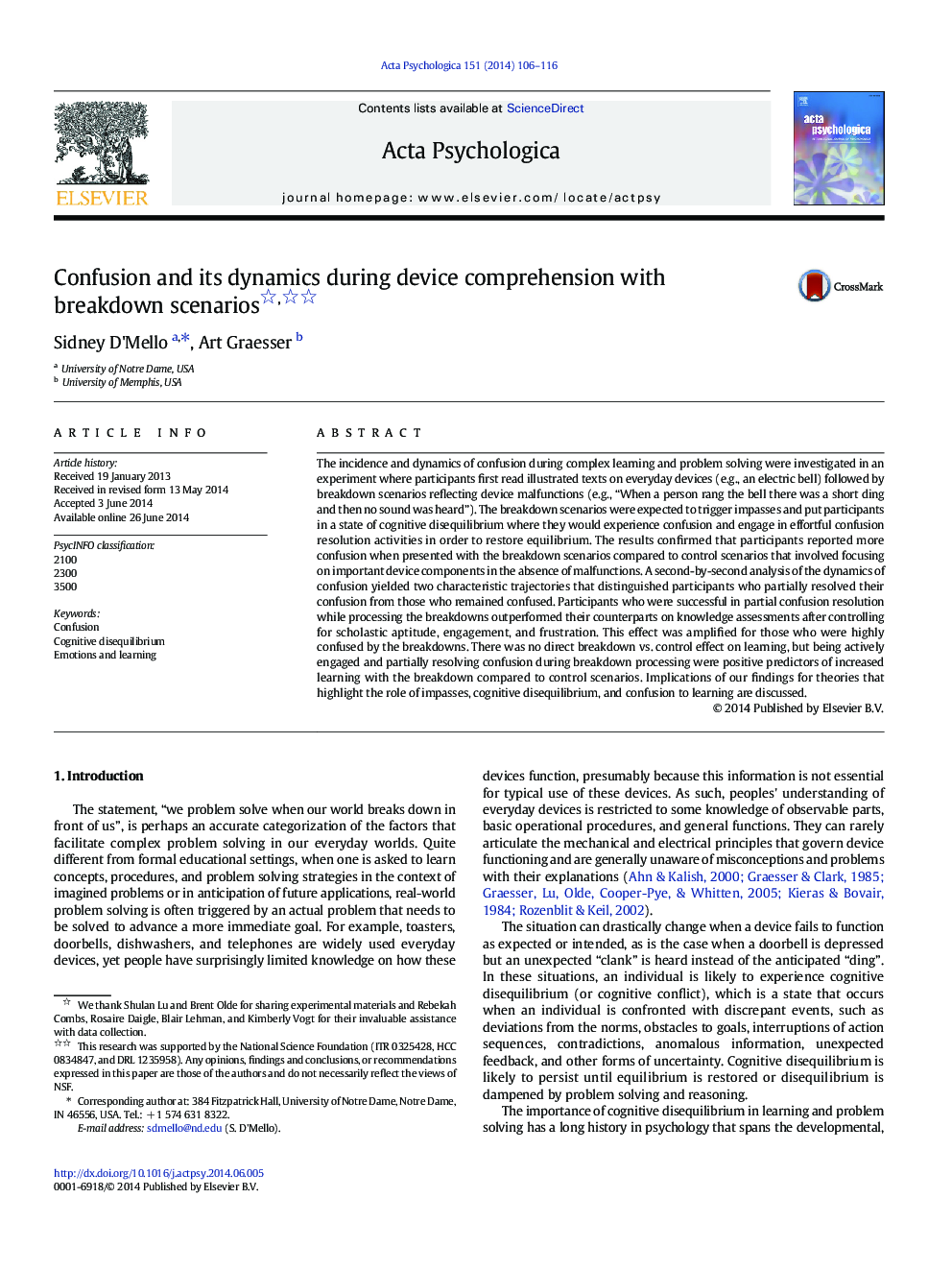| کد مقاله | کد نشریه | سال انتشار | مقاله انگلیسی | نسخه تمام متن |
|---|---|---|---|---|
| 7277564 | 1473607 | 2014 | 11 صفحه PDF | دانلود رایگان |
عنوان انگلیسی مقاله ISI
Confusion and its dynamics during device comprehension with breakdown scenarios
ترجمه فارسی عنوان
سردرگمی و پویایی آن در حین درک دستگاه با سناریوهای شکست
دانلود مقاله + سفارش ترجمه
دانلود مقاله ISI انگلیسی
رایگان برای ایرانیان
کلمات کلیدی
2100، 2300، 3500، گیجی، عدم تعادل شناختی، احساسات و یادگیری،
ترجمه چکیده
بروز و پویایی سردرگمی در طول یادگیری پیچیده و حل مسئله در یک آزمایش که در آن شرکت کنندگان برای اولین بار به عنوان خوانده شده متون در دستگاه های روزمره (به عنوان مثال، زنگ الکتریکی) به دنبال سناریو های شکستن منعکس کننده دستگاه های خراب (به عنوان مثال، هنگامی که یک نفر زنگ زد زنگ یک دینگ کوتاه بود و پس از آن هیچ صدایی شنید؟) انتظار میرود که سناریوهای تجزیه و تحلیل، موجب نابودی و قرار دادن شرکت کنندگان در عدم تعادل شناختی شوند، در صورتی که آنها به سردرگمی و مشاجره در فعالیتهای حل و فصل اشتباه در تلاش برای بازگرداندن تعادل دست خواهند یافت. نتایج حاکی از آن است که شرکت کنندگان در هنگام ارسال با سناریوهای شکست در مقایسه با سناریوهای کنترل که در صورت عدم کارکرد ناکافی، تمرکز بر اجزای مهم دستگاه را نشان می دهند، بیشترین سردرگمی را گزارش کردند. تجزیه و تحلیل دوم توسط دوم پویایی گیجی ناشی از دو مسیر مشخص که شرکت کنندگان را متمایز می کند، که تا حدی سردرگمی خود را از کسانی که باقی مانده اند، گیج می شوند. شرکت کنندگان که در حل و فصل اختلال جزئی در حین پردازش شکست ها موفقیت آمیز بودند، همتایان خود را بر مبنای ارزیابی دانش پس از کنترل توانایی تحصیلی، مشارکت و ناامیدی سوق داد. این اثر برای کسانی که به شدت گیج شده بودند، تقویت شد. هیچ تاثیر مستقیمی در مقابل تاثیر کنترل بر یادگیری وجود نداشت، اما فعالانه درگیر شد و بخشی از اختلال در پردازش تجزیه و تحلیل، پیش بینی های مثبت افزایش یادگیری با شکست در مقایسه با سناریوهای کنترل بود. پیامدهای یافته های ما برای نظریه هایی که نقشی برجای می گذارد، عدم تعادل شناختی و سردرگمی در یادگیری را مورد بحث قرار می دهد.
موضوعات مرتبط
علوم زیستی و بیوفناوری
علم عصب شناسی
علوم اعصاب شناختی
چکیده انگلیسی
The incidence and dynamics of confusion during complex learning and problem solving were investigated in an experiment where participants first read illustrated texts on everyday devices (e.g., an electric bell) followed by breakdown scenarios reflecting device malfunctions (e.g., “When a person rang the bell there was a short ding and then no sound was heard”). The breakdown scenarios were expected to trigger impasses and put participants in a state of cognitive disequilibrium where they would experience confusion and engage in effortful confusion resolution activities in order to restore equilibrium. The results confirmed that participants reported more confusion when presented with the breakdown scenarios compared to control scenarios that involved focusing on important device components in the absence of malfunctions. A second-by-second analysis of the dynamics of confusion yielded two characteristic trajectories that distinguished participants who partially resolved their confusion from those who remained confused. Participants who were successful in partial confusion resolution while processing the breakdowns outperformed their counterparts on knowledge assessments after controlling for scholastic aptitude, engagement, and frustration. This effect was amplified for those who were highly confused by the breakdowns. There was no direct breakdown vs. control effect on learning, but being actively engaged and partially resolving confusion during breakdown processing were positive predictors of increased learning with the breakdown compared to control scenarios. Implications of our findings for theories that highlight the role of impasses, cognitive disequilibrium, and confusion to learning are discussed.
ناشر
Database: Elsevier - ScienceDirect (ساینس دایرکت)
Journal: Acta Psychologica - Volume 151, September 2014, Pages 106-116
Journal: Acta Psychologica - Volume 151, September 2014, Pages 106-116
نویسندگان
Sidney D'Mello, Art Graesser,
